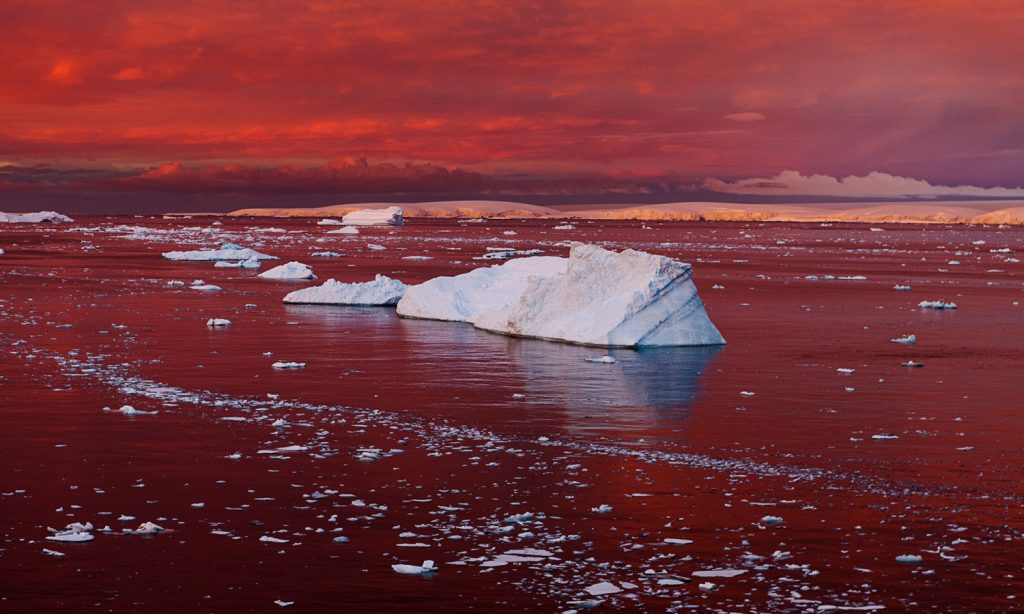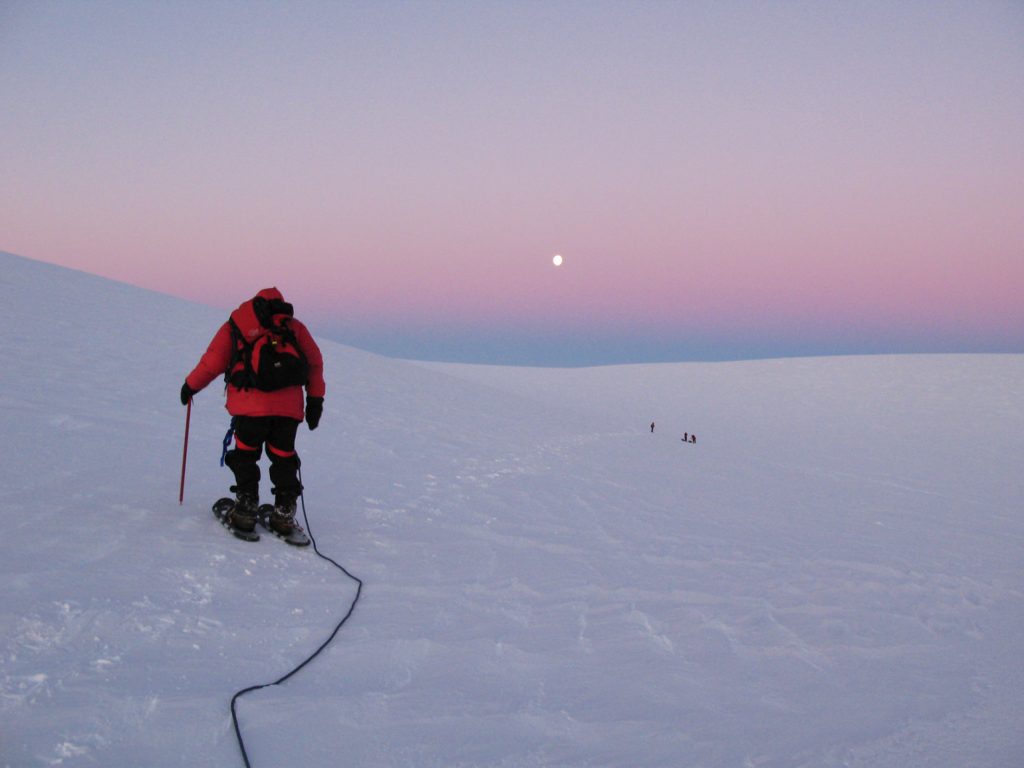The loss of polar ice may seem like an abstract concern, but it’s one that will affect all of us, no matter where we live, says glaciologist and TED Senior Fellow Michele Koppes.
I first went to work in Antarctica in 2000. I’m a glaciologist, and even though I’d grown up hiking near the glaciers of the Swiss Alps, the ice and landscape near the South Pole were completely different than anything I’d ever seen before. The ice was so vast that from the vantage of our airplane, it stretched all the way to the horizon and continued to extend for hours as we flew over it. The climate was so cold, windy and harsh there, one immediately feels like an intruder. Antarctica is not made for humans, and rightfully so as there should be one place on this planet that we cannot put our sticky, oily handprints all over. But we are doing just that, even from our comfortable homes in temperate climes, and the ice in Antarctica is waking up and shifting in response.
Last year, we saw the largest iceberg ever — a piece of the Larsen C Ice Shelf — break off of Antarctica. The size of Delaware, or of Prince Edward Island (if you are from Canada), or of half of Wales (if you prefer European sizing), this berg holds one trillion tons of ice. It is expected to drift north and slowly melt into the ocean over the next 10 years or so, perhaps making it all the way to the equator before its last ice crystal vanishes into the sea.

Even though the public may have been surprised by this collapse, the scientific community was not. I’ve been working in glaciology for 20 years, and we’ve been observing a crack in the ice shelf grow and expecting a rupture for the last decade. While the size of the iceberg is significant, it’s far from the only one being shed near the poles — ice shelves are disintegrating all over Antarctica and up in Greenland as well. What scientists don’t yet know is this: how quickly will we experience the cascading effects from these collapses?
From our partners:
You can think of an ice shelf as a cork made of ice that has slid off the land and is sitting on top of the ocean. It serves as a stopper for all the ice that is parked on the land. When that cork is removed, the rest of the shelf disintegrates all the way back to what we call the grounding line, or the point at which ice is thick enough that it is no longer floating on the ocean. Then, because the ice on the land no longer has a backstop to prevent it from moving, it will accelerate and slide towards the ocean. Mountains slopes that are no longer being held up by the thinning ice will collapse, triggering landslides.

When these landslides run into lakes and the ocean, they can generate tsunamis. In early June, for example, a massive landslide and tsunami occurred with no warning in a fjord in western Greenland, inundating a village and killing four people. Global sea levels will also rise, because the Earth’s finite reserves of freshwater that were once stored as ice on the land, end up melting into the ocean instead. This infusion of cold freshwater into warm, salty seawater then changes the ocean’s thermohaline circulation — which is how heat and salt are carried throughout the world — and creates more extreme weather patterns.
Every time you fly down to Antarctica, you reach a point about midway through the flight that’s called the Point of No Return — the point when the pilots have to decide whether weather conditions are stable enough for the plane to land on the ice, or whether they should turn back to the safety of base. Today we’ve passed the Point of No Return for our planet and its ice masses, and there’s no home base we humans can escape back to.
The term “climate change” is a bit misleading, because what’s happening is about so much more than rising temperatures — it’s about how all the different parts of the Earth’s system are being affected by the climate. The impact will be different depending on where you live. The glaciers of my youth in Switzerland are now fewer and smaller, and some have disappeared altogether, permanently altering the landscape. Some of the once-clear, icy-cold glacial streams I loved to drink from have become swollen and brown from sediment.
Maybe you’ll experience more frequent and larger wildfires, or more destructive landslides, or more catastrophic floods. Many farmers and ranchers will find their critical summer water supply drying up, threatening their crops and animals. Fisherfolk who ply the lakes, streams and rivers will see a decrease in aquatic species as some die off because those bodies of water are too warm, too low or too flashy to sustain them. In the Arctic Ocean, the bottom-feeding fish and the marine mammals that consume them will die off because fjord waters will become turbid from the sediment left by melting ice. And all of these effects will be felt by those of us who depend on farming, ranching or fishing for our food.
People will start moving inland, away from flood-prone coastal towns and cities (like Mumbai and Miami), and their migration will strain the resources of the places where they relocate. And there are many other cascading effects from the loss of ice that will impact us in equally big and dramatic ways and that scientists are beginning to understand. All of the changes — whether they’re occurring in the land, sea or sky — are intertwined; they’re irreversible; they’re complex and cumulative; and they are happening more and more rapidly.
In 2002, I was doing fieldwork on a research ship in the Antarctic Peninsula when the Larsen B Ice Shelf started to collapse. At sea level, all we could see was an unbroken, 100-meter-tall wall of ice that stretched from horizon to horizon (the Wall in the Game of Thrones has an eerie resemblance to it). The only indication that something was amiss was that the ice wall was much closer to our ship than what was plotted on the nautical chart. The ship keeps a record of tracks it has sailed, and we were trying to follow the same track it had taken only the summer before, but the ice was barring our way. It wasn’t until after we returned to port that we heard the ice shelf had disintegrated — we’d been dancing among the splinters of icebergs.
We’re all dancing among the icebergs now, and we have a choice: we can try to hold onto the futile dream of returning to the way things once were, or we can talk, think and prepare for how we’ll live on this new Earth.
This article is written by Michele Koppes, originally appeared in TED.
Michele Koppes is an Associate Professor of Geography at the University of British Columbia, a Canada Research Chair in Landscapes of Climate Change, and a Senior TED Fellow. Her passion is forensic geomorphology: reading landscapes to decipher the forces that shaped them. She is especially interested in how glaciers and the landscapes they produce shape, and are shaped by, society. She has a strong need to ground our understanding of earth surface processes in on-the-ground observations, and hence dedicates much of her time to fieldwork in hard to reach places all over the world, from the mountains of British Columbia to Patagonia, Alaska, the Himalayas, Greenland and Antarctica, where she and her students combine detailed field observations with numerical and theoretical modeling of the interactions between the ice, the mountains, the ocean and the people.
















